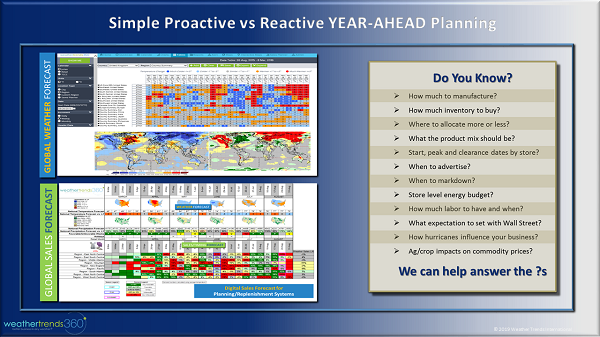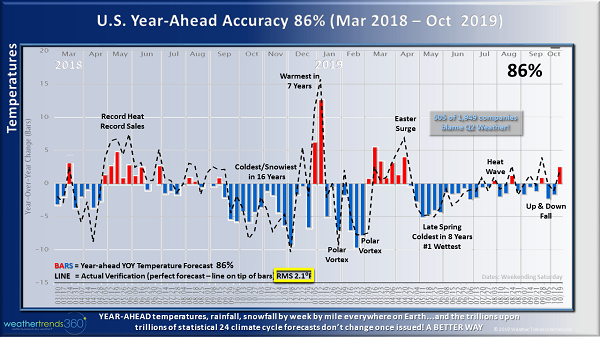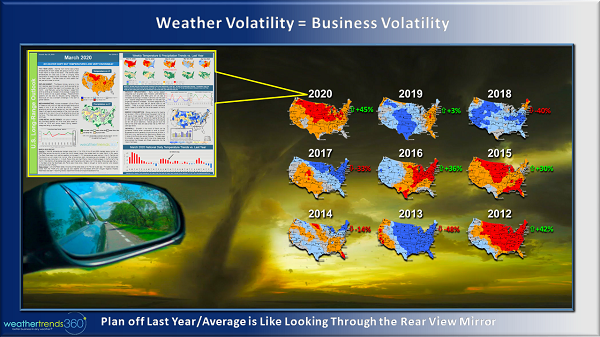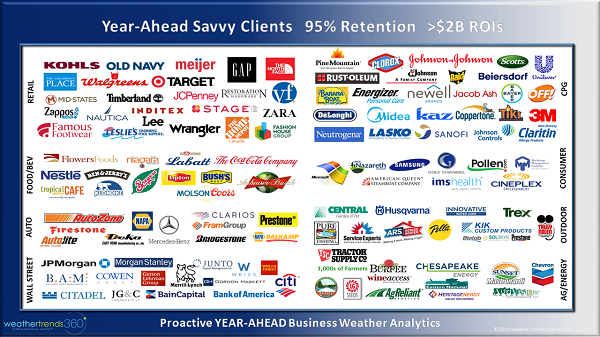5 Ways Retailers Use Long-Range Forecasting
Business
Retailers need 6-12 months to plan inventory, pricing, logistics and more. But predicting what consumers want a year before they buy is still hit and miss. In this post, we review how long-range weather forecasting can help.
It's almost impossible to predict what consumers want before they want it. There are too many variables at play. And one of the biggest, the weather, has enough variables of its own to drive a merchandise planner crazy. As a result, savvy retailers are turning to long-range weather forecasting to better anticipate how the weather will influence consumer demand. With that in mind, here are five ways they're using it.

Inventory
There's a clear connection between the weather and what sells. But planning inventory around the weather without losing tons of money requires an accurate forecast 6-12 months out. Traditionally, that's been impossible to achieve - meteorologists cannot accurately forecast beyond 10 days.
But that's with physics-based weather forecasting.
Developments in statistics-based long-range forecasting are forcing retailers to rethink their strategies.

For example, if you know a one degree increase in temperature translates to a 5% increase in lawnmower sales, you can plan for it. If you know how weather moves product, you can optimize your inventory around this relationship to increase sales. If you knew how warm next September was going to be, how would you adjust your inventory?
Pricing and Markdowns
Markdowns are a staple in retail for clearing shelves for the next season. The problem is most retailers do the same markdowns every year, regardless of the weather. This leaves either inventory or margin on the table.
Long-range weather forecasting provides usable data that helps you transition from one season to the next. So, you can better time and price markdowns to make more money. It can also help you find the best way to move inventory through pricing and weather. This tells you when the weather will clear the inventory, so you can keep higher prices.
The opposite is also true. If you know a season is not ideal for certain products, you start with steeper markdowns early in the season.
Advertising
An ad is more effective and delivers better ROI if timed around the weather.
For example, an ad for sunscreen isn't going to be effective in a cold and rainy April.
Retailers produce and plan commercials and ads months out. If you're going to time them for maximum impact, you need weather intelligence months in advance. Long-range forecasting can help you plan a more targeted approach, with advertising focused only on the products most likely to sell.
Store Level Budgets
Weather has a huge impact on variable expenses like utility bills and snow removal. During a heat wave or cold surge, bills can swell to the hundreds of thousands with no warning. To pay these expenses while protecting your bottom line, you need to be able to budget for weather expenses.
The problem is budgeting for this year's utilities off of last year's bill is only 20% accurate. For example, in 2016 there was a hot March in the Northeast United States. For retail stores, this led to smaller gas and snow removal bills. After experiencing a warm March, most retail stores would budget for the following March to be warm as well. But statistics-based long-range forecasting tells us there's an 86% chance the next March will be colder than average and a 94% chance it will be snowy. In this situation, a retail store that budgeted for lower gas and snow removal expenses would be unprepared for a larger than average utility bill.

Long-range weather intelligence allows you to forecast utilities and store costs like store level energy budgets. This can prevent a surprise six figure gas bill from killing your bottom line.
Logistics
The goal of a supply chain is to get the right product to the right location at the right time. But the weather can make it hard to predict what the right product or right time is.
Long-range weather intelligence can help suppliers anticipate demand months ahead. This allows you to get the right inventory to the right warehouse at the right time without having to undo it.
Let's say you're an apparel retailer with two stores in nearby cities trying to plan your inventory. Long-range forecasting can show you that (1) one location will be a degree warmer than average, and (2) the other location will be one degree below average. A slight difference in temperature between the two locations will move inventory differently.
For example, using statistics-based forecasting, we know that every one-degree colder year-over-year improves coat sales by 7%. We combine this intelligence, known as our Power of 1 Degree®", with our long-range forecast to help retailers and their suppliers better plan for the weather ahead.

With this information, you could improve your supply chain by sending less inventory to the first location and more coats to the second location. This would increase your coat sales by 7% without having to ship inventory between the stores at the last minute.
Conclusion
Long-range forecasting is changing how retailers think about the weather. It's helping the retail clients seen in the collage below to better prepare their inventory, advertising and supply chain to more accurately meet consumer demand. If you work in merchandising or planning, it's time to take a fresh look at what it can do for your forecast.

It's almost impossible to predict what consumers want before they want it. There are too many variables at play. And one of the biggest, the weather, has enough variables of its own to drive a merchandise planner crazy. As a result, savvy retailers are turning to long-range weather forecasting to better anticipate how the weather will influence consumer demand. With that in mind, here are five ways they're using it.

Inventory
There's a clear connection between the weather and what sells. But planning inventory around the weather without losing tons of money requires an accurate forecast 6-12 months out. Traditionally, that's been impossible to achieve - meteorologists cannot accurately forecast beyond 10 days.
But that's with physics-based weather forecasting.
Developments in statistics-based long-range forecasting are forcing retailers to rethink their strategies.

For example, if you know a one degree increase in temperature translates to a 5% increase in lawnmower sales, you can plan for it. If you know how weather moves product, you can optimize your inventory around this relationship to increase sales. If you knew how warm next September was going to be, how would you adjust your inventory?
Pricing and Markdowns
Markdowns are a staple in retail for clearing shelves for the next season. The problem is most retailers do the same markdowns every year, regardless of the weather. This leaves either inventory or margin on the table.
Long-range weather forecasting provides usable data that helps you transition from one season to the next. So, you can better time and price markdowns to make more money. It can also help you find the best way to move inventory through pricing and weather. This tells you when the weather will clear the inventory, so you can keep higher prices.
The opposite is also true. If you know a season is not ideal for certain products, you start with steeper markdowns early in the season.
Advertising
An ad is more effective and delivers better ROI if timed around the weather.
For example, an ad for sunscreen isn't going to be effective in a cold and rainy April.
Retailers produce and plan commercials and ads months out. If you're going to time them for maximum impact, you need weather intelligence months in advance. Long-range forecasting can help you plan a more targeted approach, with advertising focused only on the products most likely to sell.
Store Level Budgets
Weather has a huge impact on variable expenses like utility bills and snow removal. During a heat wave or cold surge, bills can swell to the hundreds of thousands with no warning. To pay these expenses while protecting your bottom line, you need to be able to budget for weather expenses.
The problem is budgeting for this year's utilities off of last year's bill is only 20% accurate. For example, in 2016 there was a hot March in the Northeast United States. For retail stores, this led to smaller gas and snow removal bills. After experiencing a warm March, most retail stores would budget for the following March to be warm as well. But statistics-based long-range forecasting tells us there's an 86% chance the next March will be colder than average and a 94% chance it will be snowy. In this situation, a retail store that budgeted for lower gas and snow removal expenses would be unprepared for a larger than average utility bill.

Long-range weather intelligence allows you to forecast utilities and store costs like store level energy budgets. This can prevent a surprise six figure gas bill from killing your bottom line.
Logistics
The goal of a supply chain is to get the right product to the right location at the right time. But the weather can make it hard to predict what the right product or right time is.
Long-range weather intelligence can help suppliers anticipate demand months ahead. This allows you to get the right inventory to the right warehouse at the right time without having to undo it.
Let's say you're an apparel retailer with two stores in nearby cities trying to plan your inventory. Long-range forecasting can show you that (1) one location will be a degree warmer than average, and (2) the other location will be one degree below average. A slight difference in temperature between the two locations will move inventory differently.
For example, using statistics-based forecasting, we know that every one-degree colder year-over-year improves coat sales by 7%. We combine this intelligence, known as our Power of 1 Degree®", with our long-range forecast to help retailers and their suppliers better plan for the weather ahead.

With this information, you could improve your supply chain by sending less inventory to the first location and more coats to the second location. This would increase your coat sales by 7% without having to ship inventory between the stores at the last minute.
Conclusion
Long-range forecasting is changing how retailers think about the weather. It's helping the retail clients seen in the collage below to better prepare their inventory, advertising and supply chain to more accurately meet consumer demand. If you work in merchandising or planning, it's time to take a fresh look at what it can do for your forecast.
